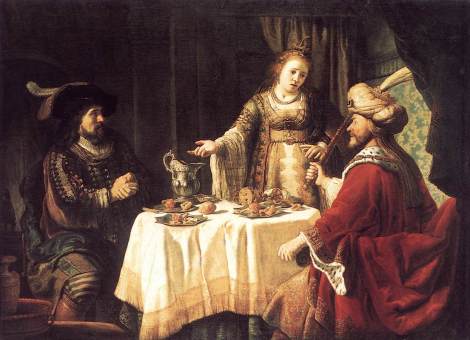There is a custom on Purim to wear masks. The origins of this practice likely lies in the Christian celebration of Carnival, and its calendrical proximity to Purim. However, the theme of dressing up is an appropriate one on Purim, as G-d is missing, or ‘hidden’ from the story, operating behind the scenes. The namesake of the Megillah, Esther, also hides her identity, her Jewishness. For this reason, Esther was a heroine of Spain and Portugal’s Jews who were forced to hide their true beliefs, and instead parade around as Catholics. Indeed, Conversos introduced Esther as a Saint into the Catholic religion, providing a path to ‘observe’ Purim in plain sight. Their identification with Esther also served to enforce a sense of self heroics. Just as Esther is celebrated on Purim for her hidden identity, Conversos saw their secret preservation of Jewish identity as similarly heroic.
The persona of Esther however, is far more complex. It is Mordekhai that instructs Esther to hide her identity, while he refuses to do so himself! Clearly then, the question of hidings one’s faith is not a simple matter. The Talmud (bSanhedrin 74) discusses it at length. Maimonides (iggeret) stated that while there may be instances when one is permitted to hide their identity that is only as long as there is no opportunity to return. However, once given that choice, remaining a Converso then becomes akin to apostasy, not forced conversion.
Indeed, while Esther remained hidden for some time, eventually, when the time was ripe, she too comes forward, and comes clean. She informs Achashverosh of her true faith. From that point forward there is no going back. She is now an open Jew. It is this action of Esther, her eventual return to Judaism that made her such a beloved figure among Amsterdam’s 17th century former Converso, or ‘New Jews’ community. They saw their circumstance as similar to hers. While at first they had hidden their identity, ultimately they returned to it, proclaiming it in public.
In our times, there is an increasing phenomenon of people discovering Sephardic ancestry. Throughout the Iberian Peninsula and in territories once ruled by Spain and Portugal, there are those exploring their past, often even returning to it. It is a wondrous trend, but it is understandably often fraught with conflicting emotions and allegiances for those going through it. There is a tendency to romanticize these discoveries, one which I personally share. We think of these descendants as modern day Esthers. It is nothing short of amazing that these individuals, and sometimes even communities, have maintained or uncovered their Jewish identity despite generations of great personal peril when it should have been lost. Sometimes they’ve even continued to retain some semblances of Jewish customs. And yet, the moment of these discoveries also coincides with moments of truth. What will come of these findings? Will these modern day Esthers actually do as Esther did and return to Judaism now that they have the opportunity to do so?
Rabbi Elisha Salas of Belmonte, Portugal told me when I visited with him that he tells Converso descendants just that when they seek him out. He tells them that up until that point they are ‘bnei anusim’, forced converts, however now that they’ve sought out a rabbi, they now must choose between a return to Judaism or risk becoming ‘meshumadim,’ apostates. It is a harsh assessment, though not entirely untrue. While they are persecuted, we can romanticize those that somehow find the courage to remain true to their heritage incognito, but once that period has past, it is time to do as Esther did and remove the veil.
Today, most descendants have a complicated status. Their ancestry is typically clouded, often requiring a conversion to fully to return to the Jewish fold (though some have amazingly successfully traced their maternal ancestry back to a Jewish matriarch!). That is a personal choice, which they don’t need to take. However, for those that wish to do so, we should celebrate and assist them as Jews have always done with the Esthers of their generation. In this age of information more and more Esthers will come forward in the years to come. Let them be welcomed as heroines, as Esther was of long ago.
Suggested Readings:
Hebrews of the Portuguese Nation: Conversos and Community in Early Modern Amsterdam (The Modern Jewish Experience) by Miriam Bodian
Rembrandt’s Jews by Steven Nadler (on depictions of Esther in Amsterdam)
My 15 Grandmothers by Genie Milgrom (on tracing her Sephardic lineage)
http://www.timesofisrael.com/queen-esther-patron-saint-of-crypto-jews/

Rabbi Morris,
At a past SCJS Conference, a professor from South America who has researched Carnival believes is was the other way around:
conversos in Rio de Janeiro started the Carnival observance as a way to celebrate Purim openly and in secret. It’s origins mesh with the arrival of the persecuted there…
Thanks for the comment. That may be the origins of Carnival in Rio, however, Carnival itself is of much earlier origin in Europe, before there were Conversos!
Pingback: Purim and the Secret Esthers of Today | © Loft Connexion By Samuel Johde on WordPress·